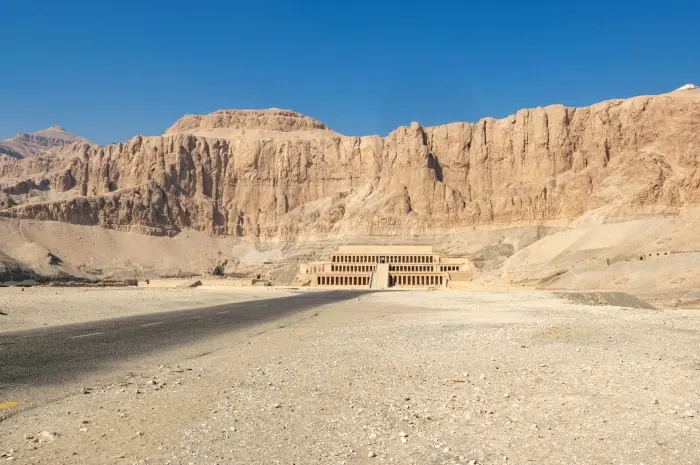History of the Valley of the Kings
The Valley of the Kings, or Biban el-Muluk in Arabic, is a valley in Egypt where, for nearly 500 years from the 16th to the 11th century BC, tombs were constructed for the pharaohs and powerful nobles of the New Kingdom.
This historic region, situated on the west bank of the Nile across from modern Luxor (ancient Thebes), is one of the most famous archaeological sites in the world and is a significant representation of the ancient Egyptians’ beliefs in the afterlife.
The valley is divided into two – the East Valley, which is most frequently visited and is where most of the royal tombs are found, and the West Valley, which has only one open tomb for viewing.
The first royal burial in the Valley of the Kings was for Pharaoh Thutmose I of the 18th dynasty, but it was during the reign of his grandson, Thutmose III, that the valley became the main area for royal burials.
The tombs themselves are an architectural marvel, intricately designed with long, narrow corridors leading to the burial chamber.
The walls of the tombs are adorned with intricate reliefs and vividly colored paintings that portray the deceased’s journey to the afterlife, highlighting ancient Egyptian cosmology and religious beliefs.
These illustrations serve not only as artistic decoration but also as a guide for the dead, helping them navigate the dangers of the underworld.
Despite the attempts to keep the tombs hidden, most were plundered in antiquity. Only the tomb of Tutankhamun was found mostly intact in the 20th century.
In 1922, British archaeologist Howard Carter discovered the virtually undisturbed tomb of Tutankhamun, bringing worldwide attention to the Valley of the Kings.
Why Visit the Valley of the Kings?
Visiting the Valley of the Kings is akin to stepping into a time machine back to ancient Egypt. This archaeological site provides an extraordinary insight into the lives, deaths, and beliefs of the pharaohs who once ruled this ancient civilization.
The tombs, although damaged and eroded over time, are a testament to the grandeur and complexity of ancient Egyptian burial rituals.
Each tomb tells its own story through detailed wall paintings, depicting religious texts, and scenes from the pharaoh’s life.
The paintings and hieroglyphic texts found within the tombs reveal much about burial rituals, society, and the religion of ancient Egypt, including their belief in the afterlife.
Moreover, the Valley’s allure is not just its tombs, but also the mystery that surrounds it. Despite centuries of archaeological exploration, it is believed that there are still undiscovered tombs waiting to be found.
The continuing exploration and discoveries keep the valley alive and continue to add to our knowledge of the New Kingdom of Egypt.
Location and Route
The Valley of the Kings is located near Luxor, in the heart of Upper Egypt. Luxor is about 650 km south of Cairo.
There are numerous ways to get to Luxor – flights from Cairo are the quickest, taking approximately one hour, or one could take a train, bus, or even a leisurely cruise along the Nile.
Once in Luxor, you’ll need to cross the Nile to the West Bank, where the valley is located. This can be done via a ferry or a motorboat.
From the boat landing, various forms of transportation are available to reach the valley, including taxis, bikes, or motorbikes. Guided tours are also a popular option, which often include visits to other nearby historical sites.
When to Visit
The best time to visit the Valley of the Kings is during Egypt’s winter months, from October to April, when temperatures are lower. The site is generally open from 6 AM to 5 PM during winter and until 7 PM in the summer.
It is recommended to arrive early in the morning when it is cooler and less crowded. Do remember to bring water, a hat, and sunscreen, as the valley is exposed and can get very hot, especially in the summer.
What to See
In the Valley of the Kings, there are over 60 tombs, but not all are open to the public, and those that are open rotate to help preserve them.
1. Tomb of Tutankhamun (KV62)
This is the most famous tomb, discovered by Howard Carter in 1922. Though smaller than others and less decorated, the discovery of this tomb, filled with treasures and the pharaoh’s mummy, stunned the world.
2. Tomb of Ramses VI (KV9)
This is one of the most elaborately decorated tombs in the valley, filled with stunning astronomical ceiling decorations.
3. Tomb of Seti I (KV17)
Known as the longest tomb in the valley, it contains well-preserved reliefs and colorful paintings.
In addition to these tombs, the site has a visitor center where you can learn more about the history of the valley, the construction of the tombs, and the lives of the ancient Egyptians.
Don’t miss the opportunity to visit the nearby Valley of the Queens and the mortuary temples, including the famous Temple of Hatshepsut.
In conclusion, the Valley of the Kings offers a unique opportunity to glimpse the grandeur, beauty, and complexity of ancient Egyptian culture.
Whether you’re an archaeology enthusiast, a history buff, or a casual tourist, the journey into this ancient royal necropolis promises an unforgettable experience.
